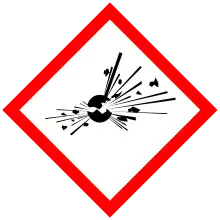 | |
 | |
 | |
| Names | |
|---|---|
| IUPAC name
Ammonium perchlorate | |
| Other names
AP | |
| Identifiers | |
3D model (JSmol) |
|
| ChemSpider | |
| ECHA InfoCard | 100.029.305 |
| EC Number |
|
PubChem CID |
|
| RTECS number |
|
| UNII | |
| UN number | 1442 |
CompTox Dashboard (EPA) |
|
| |
| |
| Properties | |
| NH4ClO4 | |
| Molar mass | 117.49 g/mol |
| Appearance | White crystalline[1] |
| Density | 1.95 g/cm3 |
| Melting point | Exothermic decomposition before melting at >200 °C[2] |
| 11.56 g/100 mL (0 °C) 20.85 g/100 mL (20 °C) 57.01 g/100 mL (100 °C) | |
| Solubility | Soluble in methanol Partially soluble in acetone, ethanol Insoluble in diethyl ether[3] |
| Structure | |
| Orthorhombic (<240 °C) Cubic (>240 °C) | |
| Hazards | |
| GHS labelling: | |
    | |
| Danger | |
| H201, H271, H319, H373 | |
| P210, P220, P221, P230, P240, P250, P260, P264, P280, P283, P305+P351+P338, P306+P360, P314, P337+P313, P370+P378, P370+P380, P371+P380+P375, P372, P373, P401, P501 | |
| NFPA 704 (fire diamond) | |
| 240 °C (464 °F; 513 K) | |
| Safety data sheet (SDS) | External MSDS[4] |
| Related compounds | |
Other anions |
Ammonium chlorate Ammonium chloride |
Other cations |
Potassium perchlorate Sodium perchlorate Lithium perchlorate |
Related compounds |
Perchloric acid |
Except where otherwise noted, data are given for materials in their standard state (at 25 °C [77 °F], 100 kPa).
Infobox references | |
Ammonium perchlorate ("AP") is an inorganic compound with the formula NH4ClO4. It is a colorless or white solid that is soluble in water. It is a powerful oxidizer. Combined with a fuel, it can be used as a rocket propellant called ammonium perchlorate composite propellant. Its instability has involved it in a number of accidents, such as the PEPCON disaster.
Production
Ammonium perchlorate (AP) is produced by reaction between ammonia and perchloric acid. This process is the main outlet for the industrial production of perchloric acid. The salt also can be produced by salt metathesis reaction of ammonium salts with sodium perchlorate. This process exploits the relatively low solubility of NH4ClO4, which is about 10% of that for sodium perchlorate.[5]
AP crystallises as colorless rhombohedra.
Decomposition
Like most ammonium salts, ammonium perchlorate decomposes before melting. Mild heating results in production of hydrogen chloride, nitrogen, oxygen, and water.
- 4 NH4ClO4 → 4 HCl + 2 N2 + 5 O2 + 6 H2O
The combustion of AP is quite complex and is widely studied. AP crystals decompose before melting, even though a thin liquid layer has been observed on crystal surfaces during high-pressure combustion processes.[6] Strong heating may lead to explosions. Complete reactions leave no residue. Pure crystals cannot sustain a flame below the pressure of 2 MPa.
AP is a Class 4 oxidizer (can undergo an explosive reaction) for particle sizes over 15 micrometres[7] and is classified as an explosive for particle sizes less than 15 micrometres.[8][9]
Applications
The primary use of ammonium perchlorate is in making solid fuel propellants.[10] When AP is mixed with a fuel (like a powdered aluminium and/or with an elastomeric binder), it can generate self-sustained combustion at pressures far below atmospheric pressure. It is an important oxidizer with a decades-long history of use in solid rocket propellants – space launch (including the Space Shuttle Solid Rocket Booster), military, amateur, and hobby high-power rockets, as well as in some fireworks.
Some "breakable" epoxy adhesives contain suspensions of AP. Upon heating to 300 °C, the AP degrades the organic adhesive, breaking the cemented joint.
Toxicity
Perchlorate itself confers little acute toxicity. For example, sodium perchlorate has an LD50 of 2–4 g/kg and is eliminated rapidly after ingestion.[5] However, chronic exposure to perchlorates, even in low concentrations, has been shown to cause various thyroid problems, as it is taken up in place of iodine.
References
- ↑ MSDS. sigmaaldrich.com.
- ↑ Liu, L.; Li, F.; Tan, L.; Ming, L.; Yi, Y. (2004), "Effects of Nanometer Ni, Cu, Al and NiCu Powders on the Thermal Decomposition of Ammonium Perchlorate", Propellants, Explosives, Pyrotechnics, 29: 34–38, doi:10.1002/prep.200400026
- ↑ John Rumble (18 June 2018). CRC Handbook of Chemistry and Physics (99th ed.). CRC Press. pp. 4–41. ISBN 978-1138561632.
- ↑ Ammonium perchlorate MSDS. Sigma-Aldrich
- 1 2 Helmut Vogt, Jan Balej, John E. Bennett, Peter Wintzer, Saeed Akbar Sheikh, Patrizio Gallone "Chlorine Oxides and Chlorine Oxygen Acids" in Ullmann's Encyclopedia of Industrial Chemistry 2002, Wiley-VCH. doi:10.1002/14356007.a06_483
- ↑ Boggs, T. L. (1970). "Deflagration Rate, Surface Structure and Subsurface Profile of Self-Deflagrating Single Crystals of Ammonium Perchlorate". AIAA Journal. 8 (5): 867–873. Bibcode:1970AIAAJ...8..867B. doi:10.2514/3.5780.
- ↑ NFPA 400: Hazardous Materials Code, 2010
- ↑ NFPA 495: Explosive Materials Code, 2010
- ↑ "Development of an Enhanced Hazard Classification System for Oxidizers Research Project, Technical Report", Safety Engineering Laboratories, Inc., The Fire Protection Research Foundation, 13 April 2006
- ↑ "Perchlorate: Overview of Issues, Status, and Remedial Actions" Archived 15 March 2012 at the Wayback Machine, ITRC, September 2005
